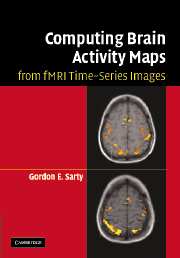3 - Experimental designs
Published online by Cambridge University Press: 07 December 2009
Summary
Before an fMRI time-series can be acquired, a question needs to be posed and an experiment designed. There are two main types of experimental design in fMRI, the blocked design and the event-related design. Figure 3.1 schematically shows the difference between the two designs. In the blocked design, a fixed number of multiple trials are presented in immediate succession in each block. The time between each trial is known as the stimulus onset asynchrony (SOA). Between blocks of stimulus presentation are blocks of rest. One cycle of blocked task and rest is known as an epoch. In an event-related design the tasks are presented individually, instead of in blocks, with a spacing, T, that may be variable. The time interval T may be further broken down into the interstimulus interval (ISI) and stimulus duration (SD) so that T = ISI + SD.
Each experimental design has its advantages and disadvantages. For example, a blocked design will generally be more sensitive to detecting activations while an event-related design may be better able to characterize the BOLD response. Both types of design rely on signal averaging to remove noise when the activation maps are computed. An event-related design with constant ISI may be considered as a limiting example of a blocked design. With both types of design, the hemodynamic response function (HRF) may be considered, in a linear systems approach, as the convolution of the stimulus paradigm (a step function equal to 1 during the stimulus and 0 otherwise) and the impulse response function (IRF).
- Type
- Chapter
- Information
- Publisher: Cambridge University PressPrint publication year: 2006



